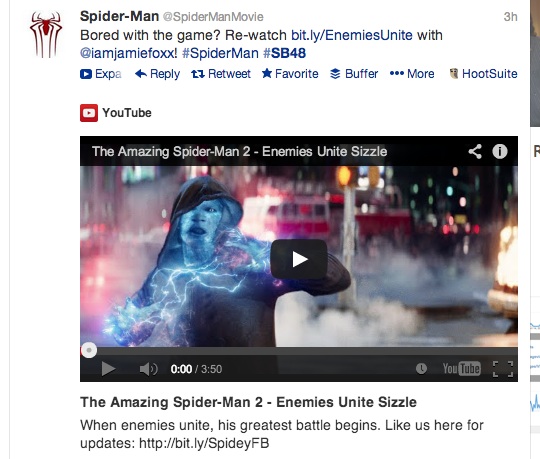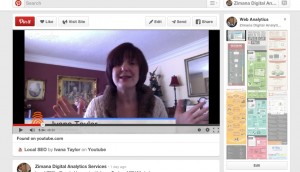
This tweet for a movie preview of The Amazing Spiderman 2 is an example of how to embed into a conversation, even as widely followed as the Super Bowl
"To make great content, make it for your customer or your audience, not for yourself." -Gary Vaynerchuk
That Gary Vaynerchuk quote can easily capture the essence of a "Positive TwitterDrop" - when an Twitter follower inserts a comment that ties into an event stream or ongoing related conversation. Admittedly the phrase Twitterdrop has a negative connotation - it is used for poor-behaving Twitter users who pretend to be in conversation with someone when they are not.
But to be positive in most people's eyes, apply a festive mood to events in which the conversation is taking place. The images in this post contain positive examples to join a conversation. The key to success is selecting events based on the persona of your desired customers.
Does your customers enjoy American Football? The Super Bowl is fast becoming the event of choice. Or does your customer enjoy "Football" - aka soccer? The World Cup fits the bill.
But if your events are on a smaller local scale, the same technique applies. Consider joining the conversation about that event.
Here are a few other ideas on how to do a PT - a Positive TwitterDrop
Back in September, I shared a talk via Skype with Martin Lindeskog, host of the topical podcast EgoNetCast (@EgoNetCast). EgoNetCast conducts interviews with authors, business minded individuals, entrepreneurs, and philosophers. Each talk is meant to answer questions on business philosophy, new media, and life.
Based in Gothenberg, Sweden, Martin is also co-host of Trendpal (@Trendpal), a lifestyle podcast with Lotta Gergis Aston (@LottaGergis). He is also a regular Small Business Trends contributor. He also goes by @Lyceum on Twitter, and is an avid tea enthusiast.
The talk Martin and I shared featured a philosophical treatise of analytics against the Trader Principle, a philosophy advocated by Ayn Rand, author of Atlas Shrugged. The trader principle declares the idea of individual justice through your trade – your ability to earn from your skills and offering. Here is a quote that further elaborates the philosophy:
“The symbol of all relationships among [rational] men, the moral symbol of respect for human beings, is the trader. We, who live by values, not by loot, are traders, both in matter and in spirit. A trader is a man who earns what he gets and does not give or take the undeserved.”
This concept dovetails into some of the underlying principles of analytics. Measurement is at the core of analytics, but analytics also reflects as an indicator of what you've earned online. Dimensions in a dashboard are sources for the metrics examined, where the metrics occurred or where they were “earned” online.
So this meaning of dimensions is an implication that the trader principle can also apply to analytics. Just think of any project where spam referral traffic is audited and you can get the idea of the Trader Principle ethics.
The talk also notes the idea of cultivating your skills. Our purpose in life is to take our skills and find ways to contribute to society. Improved skills require some form of measurement that indicates if we are getting better at the task.
There also some straightforward commentary in digital marketing such as remarketing and Twitter ads and understanding the differences of social media and paid search campaigns. This casual talk is one hour long. Click on the image in this post and enjoy. Feel free to share your thoughts as well.
By the way the talk was via Skype during an early Saturday morning for me, so forgive any "ums" as a sign of weariness! 😉
“There is no conflict of interests among men who do not desire the unearned, who do not make sacrifices nor accept them, who deal with one another as traders, giving value for value.” - Ayn Rand

This Pinterest Board, featuring an embedded Google Hangout Video, is an example of what Pinterest users typically discover and how unique content can make a difference
If you are like most people with a smartphone and a penchant for conversation, you want to share images with friends and family. One of the most popular for image sharing has been Pinterest. And if you are running a business or developing a marketing strategy for a business, you may want to take a closer look at analytic tools to measure Pinterest performance.
Stats regarding Pinterest as an attractive platform for women are well known. A Pew Institute study in late 2012 revealed a now well-known discovery that women were 5 times as likely as men to use Pinterest. More recently RJMetrics noted a sizable female presence in its study, suggesting topics that garner pins from women.
This trend plays a critical role in retail strategy. Women have been influential in major consumer purchase decisions - this Carconnection.com post notes women extending an influence in car purchases to friends and colleagues. Understandably this demographic aspect has been valuable to marketers looking to build a brand.
But other trends on Pinterest have developed since that Pew report:
These stats plus other discoveries is making Pinterest an excellent referral traffic source for segments. This makes the platform more targeted than other social media platforms in some instances.
So where do you start to measure its Pinterest activity?
Monitoring the number of pins over time may feel like the obvious first metrics choice. Pinterest makes this metric available in Pinterest Analytics, a set of dashboards with each profile.
But analytics reporting only on the number of pins does not delve into the potential reasons for why people share and pin images. The end result for businesses analyzing the activity is an overlook of meaningful behavior that can influence strategic marketing decisions.
To increase the sophistication, look at the metrics under the three dashboard segments in Pinterest Analytics:
Other Analytics Tools Available
Like Facebook and Twitter, Pinterest has berthed a series of support tools that make managing the platform easier. Here are a few resources that can be used alongside Pinterest Analytics reports
Overall, businesses are discovering new ways to measure Pinterest pins performance. These analytic solutions can reveal a branding story about products and services, and potentially bring companies closer to their customers.
Local SEO is becoming a significant factor in attracting customers were searching through smartphones and tablet devices. Local SEO may sound like a new digital hurdle for small business owners to understand. But the tactics are really straightforward, based on SEO tactics that experts have used for years, now influenced by search engine algorithms like Google’s Pigeon.
Another influence is the algorithm changes in the search engines, particularly Google. The changes have focused increasingly with mobile devices. The chart below highlights the influence Panda, Penguin, Hummingbird, and Pigeon have had on Google search results. Pigeon is the most recent change, but it also the most related to local search, interpreting local clues on a website into queries.
That difference leads to an emphasis on keywords associated with a metropolitan area, as well as phrasing in the descriptions that show up for local search. The change also impacts review sites such as Yelp. Customers with mobile phones typically access these sites, looking for local services and products.
In 2012 Search Engine Land had predicted that the majority of local search queries would be mobile by 2015. Judging by the latest data the trend is become more evident as fact.
Ultimately the influence of Pigeon, along with local SEO tactics, means businesses that people typical look for locally - pharmacies, pizzerias, restaurants, barber shops, auto repair shops, banks, laundromats, and other services - must have a website well tailored to local search and to have a robust presence on review platforms that are sharable on social media.
The customer segment that search for services are strategically important because as they discover a business through their smart device, the customer will likely decide to call or contact that business. That means that the customer is ready to purchase… and your business can potential increase sales, registrations, or any other online activity.
I sat down with Ivana Taylor of DIY Marketers to showcase basics tactics that are used with Local SEO. You can view our talk in the recorded Google Hangout below.
One tip which I provided in the hangout is the ability to track character count when modifying the title and page description of a web page. The reason for this spreadsheet tactic is to permit a better focus on arranging keywords relative to the page, title, and URL rather than worrying about the character count. Exceeding the character count will not provide any benefit in a search query and can cut off information to display and describe their services in a way that will appear in a Facebook post in a tweet.

This analytics workshop in Chicago attracted a large number of small business owners who are working to understand and improve their digital presence, so that their business can consequentially improve as well.
It happens at this time of year. Not just taking a breather with the Christmas holidays , or even reviewing financials. Each new year has become the perfect time for small and midsize businesses (SMBs) to tighten the links between their online and real-world operations.
Most SMBs know their digital presence is essential to their success, but many don't understand that once online, their core businesses will have to perform differently than before.
A USA Today article on small business trends back in 2012 offered some suggestions. If you are a regular Business Agility reader, these three points highlighted in the article may sound particularly familiar.
Another trend that caught my immediate attention was that small businesses fall into one of three categories: understanding social media, not understanding social media, or not caring about social media.
I think the small business that achieves success with social media is one that is prepared to be bold in deriving value from its operations. That value-creation drive makes it fearless in leveraging social media.
The end result is the ability to enact the steps that close a sale -- follow up by providing sales material, answer customer questions quickly, and offer information about services that anticipate customer concerns.
Gaining that intensity is possible. The starting point is gathering information on operations and making choices that leverage available assets. This can mean some initial isolation to reflect on honest feedback from employees and take in the status of a business.
This reflection does not mean becoming an isolated, brooding manager who goes to the mountaintop and returns holding stone tablets full of ideas. Instead, small businesses can start with two means to assess its capabilities, especially if a starting point is not entirely clear.
First, SMBs can review their web analytics data to learn what is working well online. As I have noted in many posts on this blog and in other sites such as CMS Wire, analytics can indicate site trends that may reflect how customers are finding and evaluating the business. These trends may also show how customer needs can be further served.
Second, a small business can also review its operations and determine what decisions keep cropping up. A recurring decision can probably be made more simply with a strategic, inexpensive purchase. If employees are on the go, what documents on the cloud should be available? And what is the best way to access them?
Using analytics to review online presence and manage business operations effectively can lead to new ways to become agile and provide true value.
It seems like everyday you read about changes in online web development you come across a new term. For those looking to improve their website or app, Front End Optimization may not feel new, but its importance certainly brings new value to a business.
Front End Optimization (FEO) is a phrase first coined by the team at Yottaa, a web testing cloud solution and development firm, in their holiday survival guide. FEO means a renewed focus in improving how a website works within a browser. It means inspecting elements rendered in the browser and improving how they are called in the DOM. The DOM is the document object model, the set if instructions that tell the browser how to render an app page or a website page.
Optimization is usually conducted through a browser development tool. Google Chrome DevTools and Firefox Firefly are popular with developers.
In addition, Microsoft offers the F12 Development Tool for the Internet Explorer 11 browser, complete with an online verification tool/support community called Internet Explorer Development Channel.
These tools are designed to inspect website elements while a page or app appears in the browser. These tools also permit live adjustments to the elements and how each element is exposed in the DOM.The following tips can organize an FEO effort to make a website or app sustainable.